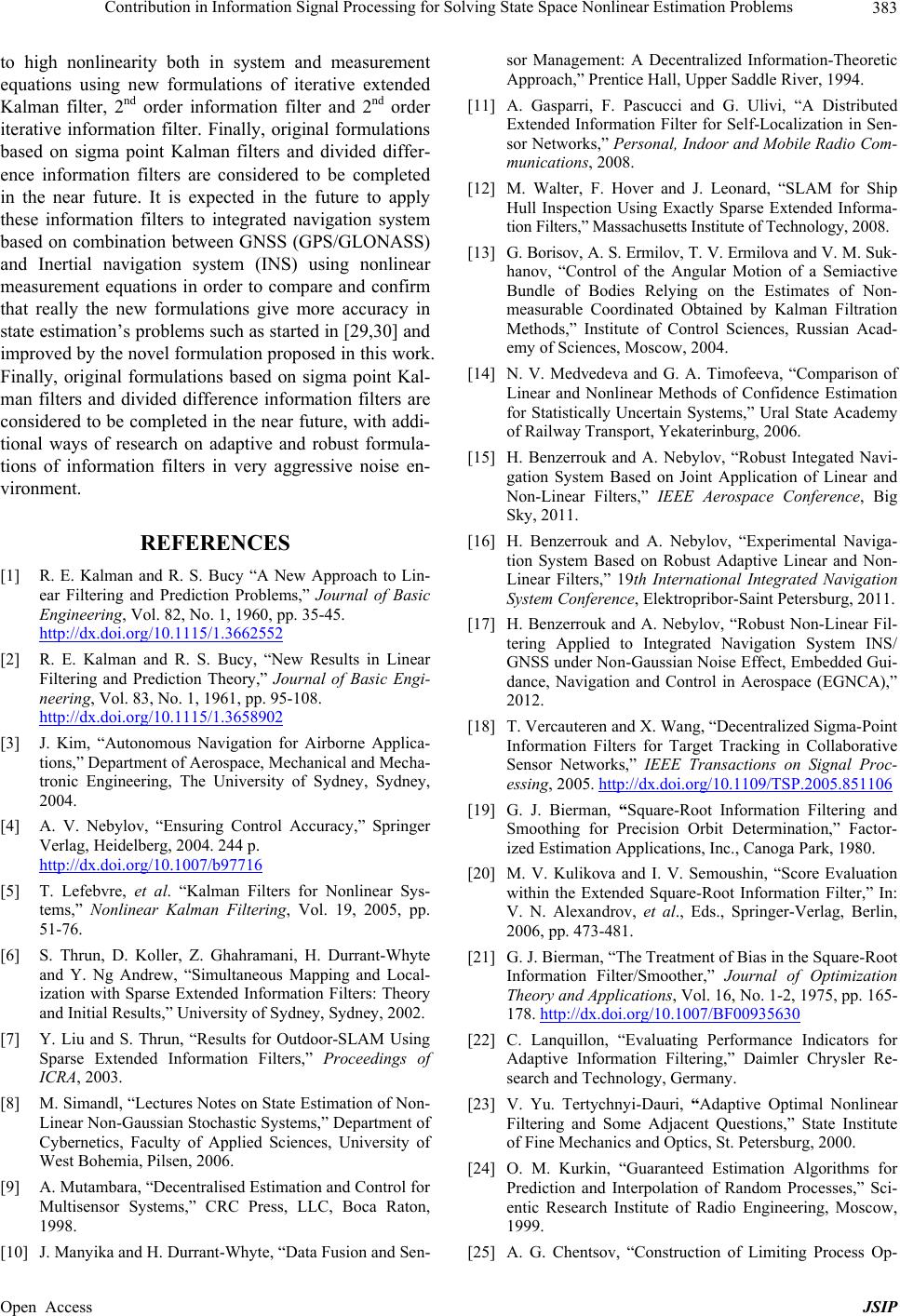
Contribution in Information Signal Processing for Solving State Space Nonlinear Estimation Problems 383
to high nonlinearity both in system and measurement
equations using new formulations of iterative extended
Kalman filter, 2nd order information filter and 2nd order
iterative information filter. Finally, original formulations
based on sigma point Kalman filters and divided differ-
ence information filters are considered to be completed
in the near future. It is expected in the future to apply
these information filters to integrated navigation system
based on combination between GNSS (GPS/GLONASS)
and Inertial navigation system (INS) using nonlinear
measurement equations in order to compare and confirm
that really the new formulations give more accuracy in
state estimation’s problems such as started in [29,30] and
improved by the novel formulation proposed in this work.
Finally, original formulations based on sigma point Kal-
man filters and divided difference information filters are
considered to be completed in the near future, with addi-
tional ways of research on adaptive and robust formula-
tions of information filters in very aggressive noise en-
vironment.
REFERENCES
[1] R. E. Kalman and R. S. Bucy “A New Approach to Lin-
ear Filtering and Prediction Problems,” Journal of Basic
Engineering, Vol. 82, No. 1, 1960, pp. 35-45.
http://dx.doi.org/10.1115/1.3662552
[2] R. E. Kalman and R. S. Bucy, “New Results in Linear
Filtering and Prediction Theory,” Journal of Basic Engi-
neering, Vol. 83, No. 1, 1961, pp. 95-108.
http://dx.doi.org/10.1115/1.3658902
[3] J. Kim, “Autonomous Navigation for Airborne Applica-
tions,” Department of Aerospace, Mechanical and Mecha-
tronic Engineering, The University of Sydney, Sydney,
2004.
[4] A. V. Nebylov, “Ensuring Control Accuracy,” Springer
Verlag, Heidelberg, 2004. 244 p.
http://dx.doi.org/10.1007/b97716
[5] T. Lefebvre, et al. “Kalman Filters for Nonlinear Sys-
tems,” Nonlinear Kalman Filtering, Vol. 19, 2005, pp.
51-76.
[6] S. Thrun, D. Koller, Z. Ghahramani, H. Durrant-Whyte
and Y. Ng Andrew, “Simultaneous Mapping and Local-
ization with Sparse Extended Information Filters: Theory
and Initial Results,” University of Sydney, Sydney, 2002.
[7] Y. Liu and S. Thrun, “Results for Outdoor-SLAM Using
Sparse Extended Information Filters,” Proceedings of
ICRA, 2003.
[8] M. Simandl, “Lectures Notes on State Estimation of Non-
Linear Non-Gaussian Stochastic Systems,” Department of
Cybernetics, Faculty of Applied Sciences, University of
West Bohemia, Pilsen, 2006.
[9] A. Mutambara, “Decentralised Estimation and Control for
Multisensor Systems,” CRC Press, LLC, Boca Raton,
1998.
[10] J. Manyika and H. Durrant-Whyte, “Data Fusion and Sen-
sor Management: A Decentralized Information-Theoretic
Approach,” Prentice Hall, Upper Saddle River, 1994.
[11] A. Gasparri, F. Pascucci and G. Ulivi, “A Distributed
Extended Information Filter for Self-Localization in Sen-
sor Networks,” Personal, Indoor and Mobile Radio Com-
munications, 2008.
[12] M. Walter, F. Hover and J. Leonard, “SLAM for Ship
Hull Inspection Using Exactly Sparse Extended Informa-
tion Filters,” Massachusetts Institute of Technology, 2008.
[13] G. Borisov, A. S. Ermilov, T. V. Ermilova and V. M. Suk-
hanov, “Control of the Angular Motion of a Semiactive
Bundle of Bodies Relying on the Estimates of Non-
measurable Coordinated Obtained by Kalman Filtration
Methods,” Institute of Control Sciences, Russian Acad-
emy of Sciences, Moscow, 2004.
[14] N. V. Medvedeva and G. A. Timofeeva, “Comparison of
Linear and Nonlinear Methods of Confidence Estimation
for Statistically Uncertain Systems,” Ural State Academy
of Railway Transport, Yekaterinburg, 2006.
[15] H. Benzerrouk and A. Nebylov, “Robust Integated Navi-
gation System Based on Joint Application of Linear and
Non-Linear Filters,” IEEE Aerospace Conference, Big
Sky, 2011.
[16] H. Benzerrouk and A. Nebylov, “Experimental Naviga-
tion System Based on Robust Adaptive Linear and Non-
Linear Filters,” 19th International Integrated Navigation
System Conference, Elektropribor-Saint Petersburg, 2011.
[17] H. Benzerrouk and A. Nebylov, “Robust Non-Linear Fil-
tering Applied to Integrated Navigation System INS/
GNSS under Non-Gaussian Noise Effect, Embedded Gui-
dance, Navigation and Control in Aerospace (EGNCA),”
2012.
[18] T. Vercauteren and X. Wang, “Decentralized Sigma-Point
Information Filters for Target Tracking in Collaborative
Sensor Networks,” IEEE Transactions on Signal Proc-
essing, 2005. http://dx.doi.org/10.1109/TSP.2005.851106
[19] G. J. Bierman, “Square-Root Information Filtering and
Smoothing for Precision Orbit Determination,” Factor-
ized Estimation Applications, Inc., Canoga Park, 1980.
[20] M. V. Kulikova and I. V. Semoushin, “Score Evaluation
within the Extended Square-Root Information Filter,” In:
V. N. Alexandrov, et al., Eds., Springer-Verlag, Berlin,
2006, pp. 473-481.
[21] G. J. Bierman, “The Treatment of Bias in the Square-Root
Information Filter/Smoother,” Journal of Optimization
Theory and Applications, Vol. 16, No. 1-2, 1975, pp. 165-
178. http://dx.doi.org/10.1007/BF00935630
[22] C. Lanquillon, “Evaluating Performance Indicators for
Adaptive Information Filtering,” Daimler Chrysler Re-
search and Technology, Germany.
[23] V. Yu. Tertychnyi-Dauri, “Adaptive Optimal Nonlinear
Filtering and Some Adjacent Questions,” State Institute
of Fine Mechanics and Optics, St. Petersburg, 2000.
[24] O. M. Kurkin, “Guaranteed Estimation Algorithms for
Prediction and Interpolation of Random Processes,” Sci-
entic Research Institute of Radio Engineering, Moscow,
1999.
[25] A. G. Chentsov, “Construction of Limiting Process Op-
Open Access JSIP